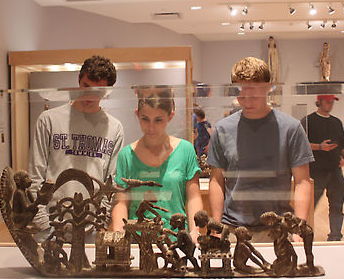American Museum of Asmat Art Director Julie Risser was the first to welcome students and visitors into the exhibition’s grand opening Thursday, Sept. 13, on the second level of the Anderson Student Center.
Risser said she put endless hours of preparation into the reception.
“When the doors open and you’ve done everything that you absolutely can, it’s a wonderful thing to share it with people who show up,” Risser said.
The Asmat are an ethnic group that inhabit the southwest region of Papua, Indonesia. The exhibit is the most comprehensive collection of Asmat art in the nation, according to Risser.
“We are really fortunate to have it here,” Risser explained. “What’s really neat is that a lot of the people who collected the works have maintained connection with the collection. So we can work with them to understand some of the pieces that come our way and learn more about them.”
The collection includes 34 quality works by a variety of artists, many of whom are women.
“We have wonderful works by women artists, who are really coming into their own now,” Risser explained. “We have a woven shield by Josita Kayoa, which is the only known woven shield in a museum collection.”
Senior Amanda Lesnikowski, gallery guard for the museum, encouraged more students to explore the gallery and what it has to offer.
“It’s worth it to come in because you’re going to learn something,” Lesnikowski said. “All different majors and areas of students have a role that they can play.”
Sophomore Libby Rihm said she was excited to learn about the new collection of art.
“It’s a brand new batch of art,” Rihm said. “People who came last semester will come back to see the new exhibit.”
Risser said the exhibition is an important learning opportunity because it ties people in Minnesota to Asmat culture.
“For people in Minnesota, you can come and learn about a culture where there are no roads,” Risser explained. “There are no cars. It’s all raised boardwalk.”
Lesnikowski said that with a high volume of Asmat art, the exhibit can rotate a variety of its pieces.
“With the collection being as large as it is, I think being able to switch them out just gives everyone a better perspective as to what we have,” Lesnikowski explained.
Risser said the gallery’s location is a great destination in the Anderson Student Center.
“It’s perfect right here specifically because it connects with so many things that our neighbors (Campus Ministry and International Studies) are doing,” Risser said.
Bjorn Saterbak can be reached at sate3878@stthomas.edu.



